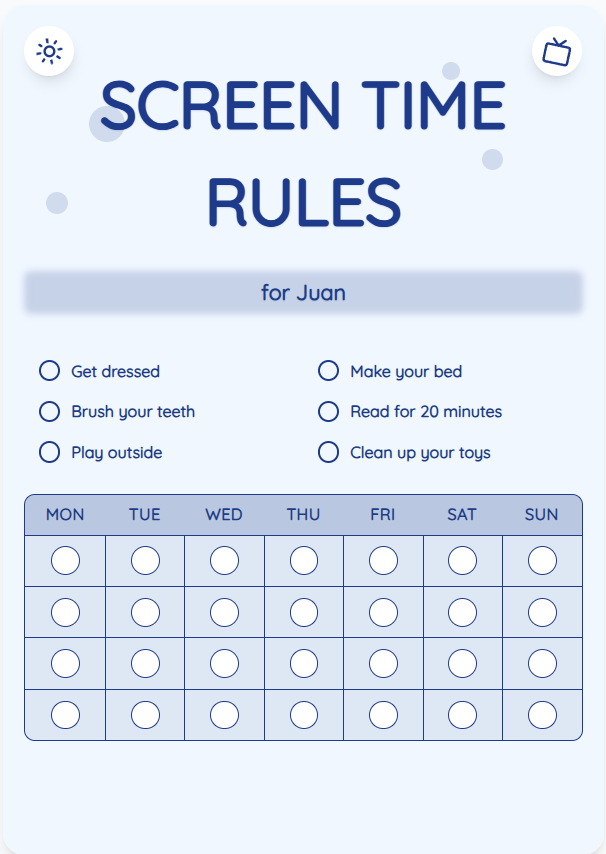Screen Time 0: A Parent's Guide to Balancing Screen Time for Kids
As a parent, finding the right balance for screen time can be challenging. In this guide, we'll explore effective strategies to manage screen time for children aged 2-12, promoting their development and well-being while maintaining family harmony.
See What Your Screen Time Chart Will Look Like
Here's an example of a beautiful, customizable screen time rules chart you can create for your family

Understanding Screen Time Guidelines
Before delving into tips, it's crucial to understand the recommended screen time limits for children in different age groups. For kids aged 2-5, the American Academy of Pediatrics suggests limiting screen time to one hour per day of high-quality programming. Children aged 6-12 can gradually increase this to up to two hours per day, with consistent breaks.
Creating a Screen Time Schedule
One effective way to manage screen time is by creating a schedule that balances screen time with other activities. Designate specific time slots for educational content, outdoor play, family time, and sleep. Use a screen time chart generator like ScreenTimeRules.com to visually represent the schedule and involve your child in the planning process.
Put These Tips Into Action
Create a custom chart to implement these strategies with your child
Setting Screen Time Rules and Boundaries
Establish clear rules around screen time usage, such as no screens during meal times or an hour before bedtime. Create designated screen-free zones in your home, like the dining area and bedrooms. Encourage healthy habits by rewarding non-screen activities and modeling balanced screen use yourself.
Promoting Alternative Activities
Encourage your child to engage in diverse activities beyond screens. Provide access to books, puzzles, art supplies, outdoor toys, and sports equipment. Organize family outings and game nights to foster real-life interactions and create lasting memories. Balance is key to a well-rounded childhood.
Practical Tips for Success
- Use a timer or alarm to signal when screen time is over
- Discuss screen time rules openly and involve your child in the decision-making process
- Model healthy screen habits by limiting your own screen time
- Encourage physical activity and outdoor play as alternatives to screen time
Frequently Asked Questions
How can I handle resistance when enforcing screen time limits?
It's common for children to resist restrictions on screen time. Stay consistent with the rules, offer alternative activities, and explain the reasons behind the limits. Consistency and positive reinforcement will help in the long run.
Is it okay to use screen time as a reward for good behavior?
While using screen time as a reward can be tempting, it's important to promote intrinsic motivation and teach that screen time is not the only form of entertainment or reward. Encourage positive behaviors through praise, privileges, or quality time together.
How can I monitor and track my child's screen time effectively?
Consider using parental control apps or device settings to monitor screen time usage. Set limits on specific apps or websites and review usage reports regularly. A visual screen time chart can also help track daily allocations.
By implementing these strategies and tips, you can create a healthy balance between screen time and other activities for your child. Remember, moderation is key in promoting their overall well-being and development. Visit ScreenTimeRules.com to generate personalized screen time charts and simplify the management process.
Ready to Transform Your Family's Screen Time?
Join thousands of parents who have successfully managed screen time with our customizable charts.
